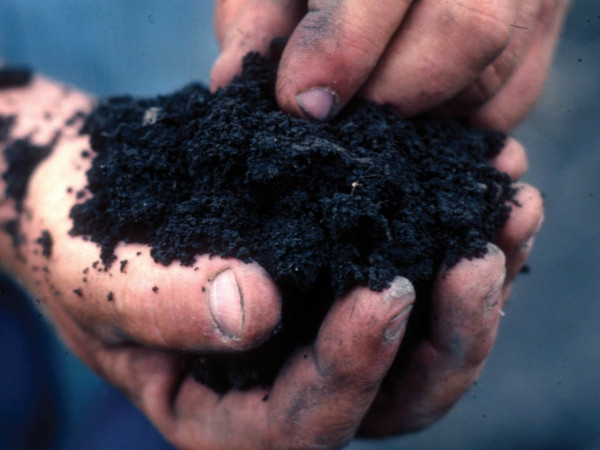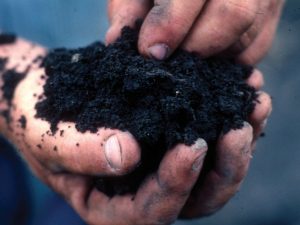“I’m a chef, I’m a cook, I was created by this industry, and I like to think I’m giving back. But I’m not giving back because I can make a scallop souffle, I’m giving back because I can make compost.” – Arthur Potts Dawson
Contents
What is composting?
Composting is the breakdown (or decomposition) of organic material (anything that was once alive) in the presence of oxygen (i.e. aerobic decomposition). Organic material can also decompose without oxygen, but this is slower and smellier, and tends to be called anaerobic decomposition or digestion (which can produce biogas). Healthy soil requires composted organic material.

The composting process involves tiny organisms, including bacteria, fungi, insects and worms. These organisms utilise the two main components of organic waste – carbon and nitrogen – and work in a series of stages. Insects, worms and other visible creatures break down organic material into a form suitable for microscopic organisms to act upon. The end result is a beautiful crumbly compost that contains a mix of minerals that plants can absorb as nutrients. There are many composting methods:
- Basic heap – a pile of material
- Enclosed containers (e.g. tumblers) – stop weed seeds blowing in
- Digesters – e.g. the Green Cone system
- Fermentation – e.g. the Bokashi system, suitable for flats
- Leaf mould – keep leaves in a bin liner or in a separate pile; they take longer to break down (up to two years) but contain minerals the tree obtained from deep in the ground, that may not be found at the surface
- Wormeries (also suitable for flats)
- Composting using other critters

A heap (loose or contained) – is the most widely used and least laborious process. There are plenty of purpose-built composters on the market, many available at subsidised rates from your local council. It’s also very easy to build your own from waste wood (e.g. pallets) and chicken wire.
Easily compostable:
- Garden waste / grass cuttings / weeds / prunings
- Kitchen waste – peelings, stems, stones, cores, anything that’s gone off
- Tea bags and coffee grounds
- Eggshells (smash them up first)
- Fruit waste, including citrus peel
- Paper (best if scrunched up)
- Cardboard, middles of toilet rolls, corks, matchsticks
- Human & pet hair
- Wood ash – contains potash (don’t add too much though)
Basic composting advice for beginners, from the RHS.
Not-so-easily compostable:
- Cooked food, meat, grease, bones, dairy produce – can attract vermin, but OK if you use the Bokashi method, Green Cone (see above), wormery (only small amounts of animal products in a wormery), or if you make it vermin-proof with a strong container, car tyres, bricks etc. (having said that, lots of people add cooked food waste to compost bins, without attracting vermin)
- Perennial or pernicious weeds – OK with Bokashi, Green Cone or wormery, or keep them in a bin liner until they are sludge, then add them to the heap
- Diseased plants – again, OK with the above systems
- Contents of vaccuum cleaner – usually inorganic, but OK if you have a natural-fibre carpet
- Sanitary products – only if made from organic materials
- Corks – take a long time

Not compostable:
- Coal ash – won’t break down
- Disposable nappies – contain inorganic materials
- Plastic, glass, metal, polythene bags – or anything inorganic
Pet waste:
Vegetarian pet waste – fine; but most advice about dog or cat faeces will be to bin it rather than compost it, due to the risk of disease. However, landfilling dog or cat waste could lead to higher risks than home composting, as it may leach into groundwater, and it won’t break down very quickly in landfill because of the lack of oxygen. Again, many people successfully add pet waste to their compost bin – allowing the compost to break down for longer, and using the compost on trees or bushes rather than veg. See here for more information and advice.

What are the benefits of composting?
In nature, plants die, break down and return to the soil, but when we grow food, we remove a crop that isn’t allowed to return to the soil. So we have to add something else if we want the soil to remain fertile – and the best thing is compost. It’s a wonderful soil improver, rich in nutrients, organic material and essential microbes to help your garden flourish.

Root systems of plants ‘grab’ the nutrients they need from composted materials in the soil, and (in the case of leguminous plants and nitrogen) from the air. Chemical fertilisers, on the other hand, are salts that are entirely water soluble, and their use causes several problems:
- Plants have to take them up when they take up water, so they become big and tasteless
- Plants don’t have to ‘work’ for their nutrients, so their root systems become weak and unhealthy
- Because they’re soluble, they leach from the land and cause pollution problems in watercourses
- They don’t add to soil structure, and so begin a downward spiral that requires more and more fertiliser
- They only contain nitrogen, phosphorus and potassium (N,P,K), not the large range of nutrients that compost does – like calcium, boron, magnesium etc, so plants suffer in the long-run
- The salts can kill some of the bacteria and fungi responsible for transferring nutrients to the plants, requiring ever-more chemical fertiliser

Other benefits of composting are:
- Saves money on buying compost
- Don’t need peat composts (which destroy peat bog habitats)
- Reduces waste sent to landfill, so reduces harmful leachates (liquids) and methane (a potent greenhouse gas), and the need for fuel for trucks to transport it
- Reduces the need for garden bonfires
- Increases biodiversity in your garden
- You can compost your confidential papers instead of shredding them!

What can I do?
Actually, you can’t stop dead organic materials composting, so you don’t have to do much really – you just have to organise your process so that it produces compost relatively quickly (unless you don’t mind how long it takes) and easily without any odours. If you have even the smallest of gardens or back yards, it really is something you should think about doing, rather than having organic material trucked away.
When choosing a site for composting, bear in mind that the process will be quicker in a sunny area, and directly on to soil. Composters can be placed in the shade or even on concrete providing there’s drainage (add a few spades of earth at the bottom to introduce necessary micro-organisms), but the process won’t be as fast.
Bokashi buckets are good if you have no space for an outdoor compost bin
It’s important to include a roughly even mixture of ‘greens’ and ‘browns’. Greens are high in nitrogen and include vegetable matter and grass cuttings. Browns provide the carbon content – examples are dead leaves, small twigs, scrunched-up paper and cardboard. These browns are very important, as they also provide structure for the heap. Without them the heap would be too compact, oxygen could become depleted, and the heap could start to degrade anaerobically (resulting in a slimy, smelly end-product, giving off methane, a greenhouse gas).
Other forms of aeration can help. Traditionally this involves ‘turning’ the heap, but that can be hard work or impossible if it’s contained. Try pushing a broom handle through the centre of the heap and ‘stirring’ instead. Specialised tools for this task are available but not necessary.

Your heap should have approximately 50% moisture content and the consistency of a wrung-out sponge. If it’s too dry, water it. If it’s too wet, add more ‘browns’. By following these guidelines, you should have compost formed at the bottom of your heap after approximately 6-9 months. If you’re in a rush add nettles, comfrey leaves, chicken manure or urine, all of which are compost accelerators. Pre-shredding your material also speeds up the process (but uses energy).
If you want to help others to compost more effectively, you could look into community composting, which may involve training for larger-scale composting and waste collection, and/or using the finished compost in public areas.

For more complex composting strategies, there are specialist books and websites (see resources). You may also be interested in our composting toilets topic. Finally, remember that there’s no such thing as ‘good compost’ – if it’s not good, it’s not compost.
Specialist(s)
Thanks to Scarlett Penn of WWOOF UK for information.
The specialist(s) below will respond to queries on this topic. Please comment in the box at the bottom of the page.

I’m Adam, I own Compost Guy, and I love composting! As a hobby, it is really fun, but not just that… It’s great for reducing waste in a household and helping the environment. Soil structure is key to healthy plants and adding compost to your beds helps with this. I have a wife and 4 lovely little kids that keep me busy. My other hobbies are scouting for birds of prey in the countryside with my kids and getting outdoors to escape screens and technology.



9 Comments
Hi
Do you have a kind of on job training on composting ? I would like to join the short course on composting.
thanks
Dewi
Hi – see courses, under resources, top right. We’ll be adding more later this year.
Hi. Looking to compost on a city rooftop: vegetable waste only, cooked and raw. What sort of setup would work best?
Hi, i made a compost bin out of old pallets and lined with cardboard in the Autumn but its slow to break down this time of year.
Is there a natural organic accelarator you can get to sprinkle on to speed up the process?
We are looking to downsize this year and am worried it will still be looking like kitchen waste!!
Try some stinging nettle, banana skins or both, they are both good activators, dont forget to turn the heap every few months and sprinkle with water if dry
Re cat poo
I successfully composted a heap of cat poo to use in the flower beds when I was fostering kittens for the local SPCA. I’m appalled at all those little plastic bags for collecting poo and this saves using any plastic (Next bit a little graphic, if you’re squeamish …..) I used biodegradable paper cat litter in their trays, picked up their droppings with local newspaper squares and put into a lidded bucket. Once bucket was full (tea tree oil helps mask odours here) I put it all in a big dustbin with a big handful of coffee grounds from the local cafe. It will compress down and still rot quite happily, a nice mix of carbon with the paper and nitrogen everything else. I left it for two years and by that time, it was just like potting mix, no smell, and the perennials in my garden loved it! 🙂
Sasha Longworth – long time since your post but in case you’re still looking for an answer, the very BEST activator is “liquid gold” (your own urine), far better than flushing it away with good water! Or if that’s not something you fancy, get the bags of coffee grounds from local cafes, they speed things up.
We just got our Hungry Bin delivered. Yippee! When assembling it, I managed to break both latches w/ the red handles. Help! I need 2 new ones. bb
Please leave your composting stories/questions on this page, and we will get back to you 🙂
Happy Composting!